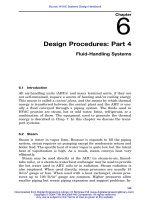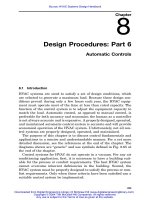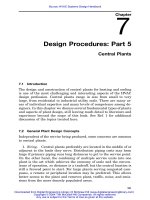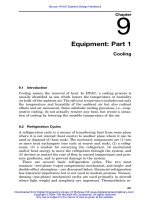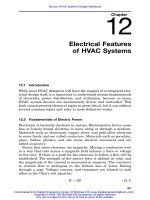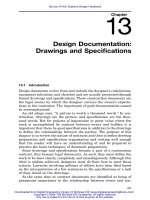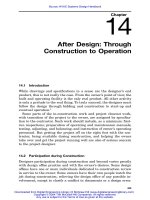Tài liệu HVAC Systems Design Handbook part 18 docx
Bạn đang xem bản rút gọn của tài liệu. Xem và tải ngay bản đầy đủ của tài liệu tại đây (92.53 KB, 10 trang )
459
Chapter
18
Engineering Fundamentals:
Part 3
Heat Transfer
18.1 Introduction
This chapter presents a basic overview of heat transfer fundamentals,
particularly as they apply to HVAC. For a detailed, rigorous treat-
ment, the reader should refer to a good college-level text on heat trans-
fer or to the ASHRAE Handbook.
1
18.2 Heat Transfer Modes
Heat is transferred between any two bodies by one or more of three
modes: conduction, convection, and radiation. Thermal conduction re-
fers to the direct transfer of energy between particles at the atomic
level. Thermal convection may include some conduction but refers pri-
marily to energy transfer by eddy mixing and diffusion, i.e., by fluids
in motion. Thermal radiation describes a complex phenomenon which
includes changes in energy form: from internal energy at the source
to electromagnetic energy for transmission, then back to internal en-
ergy at the receiver. Radiation transfer requires no intervening ma-
terial, and in fact works best in a perfect vacuum. In accordance with
the second law of thermodynamics, net heat transfer occurs in the
direction of decreasing temperature. In this text, the Fahrenheit (ЊF)
scale is used, or for absolute temperatures the Rankine (ЊR) scale:
ЊR ϭ ЊF ϩ 460Њ.
Source: HVAC Systems Design Handbook
Downloaded from Digital Engineering Library @ McGraw-Hill (www.digitalengineeringlibrary.com)
Copyright © 2004 The McGraw-Hill Companies. All rights reserved.
Any use is subject to the Terms of Use as given at the website.
460 Chapter Eighteen
Figure 18.1
Conduction heat
transfer through a wall.
18.3 Thermal Conduction
For steady-state conduction in one direction through a homogeneous
material, the Fourier equation applies:
q ϭϪkA dt/dx (18.1)
where q ϭ heat transfer rate, Btu/h
k ϭ thermal conductivity, Btu/(h ⅐ ft ⅐ ЊF)
A ϭ area normal to flow, ft
2
dt/dx ϭ temperature gradient, ЊF/ft
The minus sign shows that heat flow takes place from a higher to a
lower temperature.
In HVAC calculations, homogeneous barriers are never encount-
ered—even when the solid barrier is homogeneous, there will be film
resistance at its surface, as shown in Fig. 18.1. The heat transfer equa-
tion is then modified as follows:
q ϭ UA(T Ϫ T ) (18.2)
12
where U is the overall coefficient of heat transfer per degree of tem-
perature difference between the two fluids which are separated by the
barrier. Usually, but not always, U is given in Btu per hour per square
foot per degree Fahrenheit. The temperatures and the area A must be
in units consistent with those of U.
Various building materials and combinations thereof have been
tested to determine the conductivity k (Btu per hour per square foot
per inch or foot of thickness per degree Fahrenheit) or conductance C
(for a nonhomogeneous material such as a concrete block, in Btu per
hour per square foot per degree Fahrenheit). The tests are made in a
Engineering Fundamentals: Part 3
Downloaded from Digital Engineering Library @ McGraw-Hill (www.digitalengineeringlibrary.com)
Copyright © 2004 The McGraw-Hill Companies. All rights reserved.
Any use is subject to the Terms of Use as given at the website.
Engineering Fundamentals: Part 3 461
‘‘guarded hot box,’’ designed so that heat transfer through the edges
of the material is essentially eliminated. The results of these tests are
tabulated and presented, with discussion, in the ASHRAE Handbook.
2
The thermal conductivity k of any material is the reciprocal of its
resistance R:
1
k ϭ (18.3)
R
For barriers with material combinations which are not tabulated, the
U factor may be calculated from the sum of the individual resistances.
The general form of the equation is
1
ϭ R ϩ R ϩ R ϩ ⅐⅐⅐ϩ R (18.4)
123 n
U
Because resistance is the reciprocal of conductance or conductivity, a
more specific form of the equation is
11xx111
1 n
ϭϩ ϩ⅐⅐⅐ϩϩ ϩ⅐⅐⅐ϩϩ (18.5)
Uf k k C C f
o 1 n 1 ni
where f
o
ϭ outside film conductance
f
i
ϭ inside film conductance
x ϭ thickness of homogeneous section with conductivity k
See Ref. 2 for a more detailed discussion. The incremental tempera-
ture drop through each element of the barrier is proportional to the
resistance of the element. For example, in Fig. 18.1 if the wall is 6-in-
thick perlite concrete with a k value of 0.93 per inch, and if the outside
and inside film conductances are 4.00 and 1.46, respectively, then the
overall U factor is
1161
ϭϩϩ
U 4.00 0.93 1.46
ϭ 0.25 ϩ 6.45 ϩ 0.68 ϭ 7.38
1
U ϭϭ0.136
7.38
If a temperature difference of 42ЊF is assumed, based on 72ЊF inside
and 30ЊF outside, then the temperature gradient can be determined
as shown in Table 18.1. This type of calculation is useful in determin-
ing the location where moisture condensation or freezing will take
Engineering Fundamentals: Part 3
Downloaded from Digital Engineering Library @ McGraw-Hill (www.digitalengineeringlibrary.com)
Copyright © 2004 The McGraw-Hill Companies. All rights reserved.
Any use is subject to the Terms of Use as given at the website.
462 Chapter Eighteen
TABLE
18.1 Temperature Gradient Information
place, such as on inside window surfaces. To avoid problems, extra
insulation, double glazing, or surface heating may then be used.
In HVAC practice, steady-state conduction seldom, if ever, takes
place, because the outside air temperature and inside load conditions
are constantly changing. The transient heat flow effects which result
are functions of several variables, including the mass (storage effect)
of the barrier. The sensible heat gain and cooling load factors dis-
cussed in Chap. 3 are approximations which allow the designer to
compensate for these transients.
18.4 Thermal Convection
Thermal convection refers to heat transfer by eddy mixing and diffu-
sion, as in a flowing airstream. In the typical airstream heating or
cooling process, heat transfer takes place as a result of mixing with,
and diffusion through, the air in the conditioned space. The final
transfer is by conduction between air particles. Convection may be
natural or free convection, due to differences in density, or it may be
forced by mechanical means such as fans or pumps.
An HVAC process illustrating almost pure convective heat transfer
is the mixing of two airstreams such as return air and outside air. If
complete mixing takes place, the mixed airstream has a temperature
(and humidity) resulting from a weighed average of the properties and
masses of the two original air-streams. This is a result of convective
eddy mixing and diffusion plus conductive heat transfer between par-
ticles.
A major HVAC application involving a combination of convection
and conduction is heat exchange between two fluids such as refriger-
ant, water, steam, brine, and air, in many combinations. In general,
the two fluids are separated by a barrier, usually the wall of a tube or
pipe. Typical examples are the shell-and-tube heat exchanger (see Fig.
Engineering Fundamentals: Part 3
Downloaded from Digital Engineering Library @ McGraw-Hill (www.digitalengineeringlibrary.com)
Copyright © 2004 The McGraw-Hill Companies. All rights reserved.
Any use is subject to the Terms of Use as given at the website.
Engineering Fundamentals: Part 3 463
Figure 18.2
Heat transfer through a tube wall.
Figure 18.3
Velocity pattern for
fluid flow in a conduit.
9.10) and the finned coil (see Fig. 9.20). In both cases, the barrier is
a tube wall, as in Fig. 18.2. Heat transfer takes place within each fluid
stream by convection, then by conduction through the wall and the
contiguous films. The velocity of a fluid stream flowing uniformly in a
conduit (tube or duct) is greatest at the center of the conduit and least
near the edges (Fig. 18.3). This is due to friction of the fluid particles
against the wall and against each other. The films of nearly motionless
fluids on each side of the wall resist heat transfer, as noted above.
Because the tubes in heat exchangers are usually copper, with its high
conductivity factor, the films provide the major part of the resistance.
Additional resistance is provided by the buildup of dirt, oil, or solids
deposition on the tube surface. This is known as the fouling factor,
and it is usually significant.
The film resistance is a function of the fluid velocity, being highest
with laminar flow and lowest with turbulent flow. To estimate the
degree of turbulence in a system, the Reynolds number Re is calcu-
lated:
DV
Re ϭ (18.6)
where D ϭ conduit diameter, ft
V ϭ average fluid velocity, ft/s
ϭ fluid viscosity, lb/(ft ⅐ s)
ϭ density, lb/ft
3
The transition value of the Reynolds number is in the range of 2100
Engineering Fundamentals: Part 3
Downloaded from Digital Engineering Library @ McGraw-Hill (www.digitalengineeringlibrary.com)
Copyright © 2004 The McGraw-Hill Companies. All rights reserved.
Any use is subject to the Terms of Use as given at the website.
